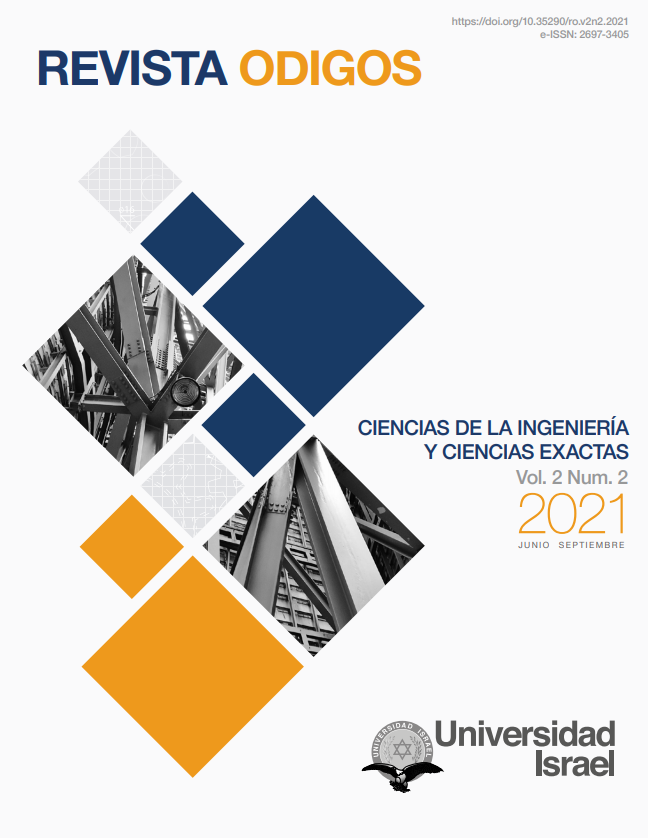Estimation of transient electrical parameters of a transformer using curve fitting with nonlinear optimization
DOI:
https://doi.org/10.35290/ro.v2n2.2021.442Keywords:
transformer, high voltage, transfer function, electric transient parametersAbstract
This study proposes an alternative to obtain the electrical parameters in three-phase transformer models by means of records obtained with readings from measuring devices in protection and monitoring systems associated with the electrical transformer. The possible use of this procedure focuses on the estimation of the electrical model in three-phase transformers during their operation and functioning in an electrical system and their response to transient events. This proposal will reduce resources and time use in comparison with existing methodologies, since these usually require the transformer to be out of service for the connection of high-cost specialized equipment, being often necessary to move the transformer to a specialized laboratory.
Existing works provide complete transformer models for simulation of transient events, these were used as starting data to tune the parameters in MATLAB-SIMULINK. Evaluated the effectiveness and reliability of the study, it will be of great help in the determination of transient electrical parameters in new transformers or with a considerable time of operation, because due to the use of the equipment and the operating conditions, the electrical parameters may vary with respect to their factory records.
Downloads
References
Abed, N.Y., Mohammed, O.A. (2010). Physics-Based High-Frequency Transformer Modeling by Finite Elements. Magnetics, IEEE Transactions on Magnetics, vol. 46, no. 8, 3249-3252. https://doi.org/10.1109/TMAG.2010.2048017
Biernacki, J., Czarkowski, D. (2001). High frequency transformer modeling. In ISCAS 2001 - 2001 IEEE International Symposium on Circuits and Systems, The 2001 IEEE International Symposium on Circuits and Systems (Cat. No. 01CH37196), (Vol. 3, pp. 676-679). IEEE. https://doi.org/10.1109/ISCAS.2001.921401
Chiguano, B., Ramírez, J., Quilumba, F., & Gallardo, C. (2018). Estimación de los Parámetros Eléctricos de un Generador Sincrónico basada en Mediciones de Laboratorio usando Métodos de Optimización No Lineal. Revista Técnica Energía. 15(1), 30-43. https://doi.org/10.37116/revistaenergia.v15.n1.2018.321
Galván, V., Gutiérrez, J., Ortiz, V., Sánchez, R. (2012). Modelado del transformador para eventos de alta frecuencia. Ingeniería Energética, 33(2), 122-132. http://scielo.sld.cu/scielo.php?script=sci_arttext&pid=S1815-59012012000200005&lng=es&tlng=es
Xexplore, I. (2015). C57.12.00-2015 - IEEE Standard for General Requirements for Liquid-Immersed Distribution, Power, and Regulating Transformers. IEEE https://doi.org/10.1109/IEEESTD.2016.7469278
MathWorks. (2019). How the Software Formulates Parameter Estimation as an Optimization Problem—MATLAB & Simulink—MathWorks América Latina. https://la.mathworks.com/help/sldo/ug/optimization-problemformulation-for-parameter-estimation.html#d117e4545
Mork, B. A., Gonzalez, F., Ishchenko, D., Stuehm, D. L., & Mitra, J. (2007). Hybrid transformer model for transient simulation—Part I: Development and parameters. IEEE Transactions on Power Delivery, 22(1), 248-255.
Moziful Islam, S., Coates, K. M., & Ledwich, G. (1997, October). Identification of high frequency transformer equivalent circuit using Matlab from frequency domain data. In IAS'97. Conference Record of the 1997 IEEE Industry Applications Conference Thirty-Second IAS Annual Meeting (Vol. 1, pp. 357-364). IEEE. https://ieeexplore.ieee.org/abstract/document/643049
NMX-J-169-ANCE-2004. (2004). Transformadores y Autotransformadores de Distribución y Potencia”, Métodos de Prueba.
Tibanlombo, V. (2018). Estudio de la respuesta en frecuencia mediante pruebas de impulso para la evaluación del estado del aislamiento en transformadores. EPN http://bibdigital.epn.edu.ec/handle/15000/19719
Published
How to Cite
Issue
Section
License
Copyright (c) 2021 Víctor Hugo Tibanlombo Timbila, Andrés Alfredo Guevara Betancourt y Juan David Ramírez Guasgua

This work is licensed under a Creative Commons Attribution 4.0 International License.
Los autores que participen de los procesos de evaluación y publicación de sus ediciones conservan sus derechos de autor, cediendo a la revista el derecho a la primera publicación, tal como establecen las condiciones de reconocimiento en la licencia Creative Commons Reconocimiento 4.0 Internacional (CC BY), donde los autores autorizan el libre acceso a sus obras, permitiendo que los lectores copien, distribuyan y transmitan por diversos medios, garantizando una amplia difusión del conocimiento científico publicado.
- Toda derivación, a partir de esta obra, deberá citar la fuente y a la primera publicación en esta revista. Se permiten derechos comerciales no lucrativos sobre sus contenidos.
- Los autores pueden realizar otros acuerdos contractuales independientes y adicionales para la distribución no exclusiva de la versión del artículo publicado en esta revista, es decir, podrán incluirlo en un repositorio institucional o publicarlo en un libro, siempre que indiquen claramente que el trabajo se publicó por primera vez en esta revista.
- Se permite y recomienda a los autores compartir su trabajo en línea, con la finalidad de intercambios productivos para una mayor y más rápida citación del trabajo como lo establece los efectos del movimiento ‘Acceso Abierto’.
- No puede aplicar términos legales o medidas tecnológicas que restrinjan legalmente a otros de hacer cualquier cosa que permita la licencia: https://creativecommons.org/licenses/by/4.0/deed.es
- La Revista ODIGOS es financiada completamente de los aportes realizados por nuestra entidad editora: Universidad Tecnológica Israel; por tal motivo, no establece cargos o cobros de ninguna índole a sus autores y colaboradores, así como tampoco genera pagos o remuneraciones de ningún tipo a ellos.
- Se asignará un Digital Object Identifier (DOI) a cada publicación.




